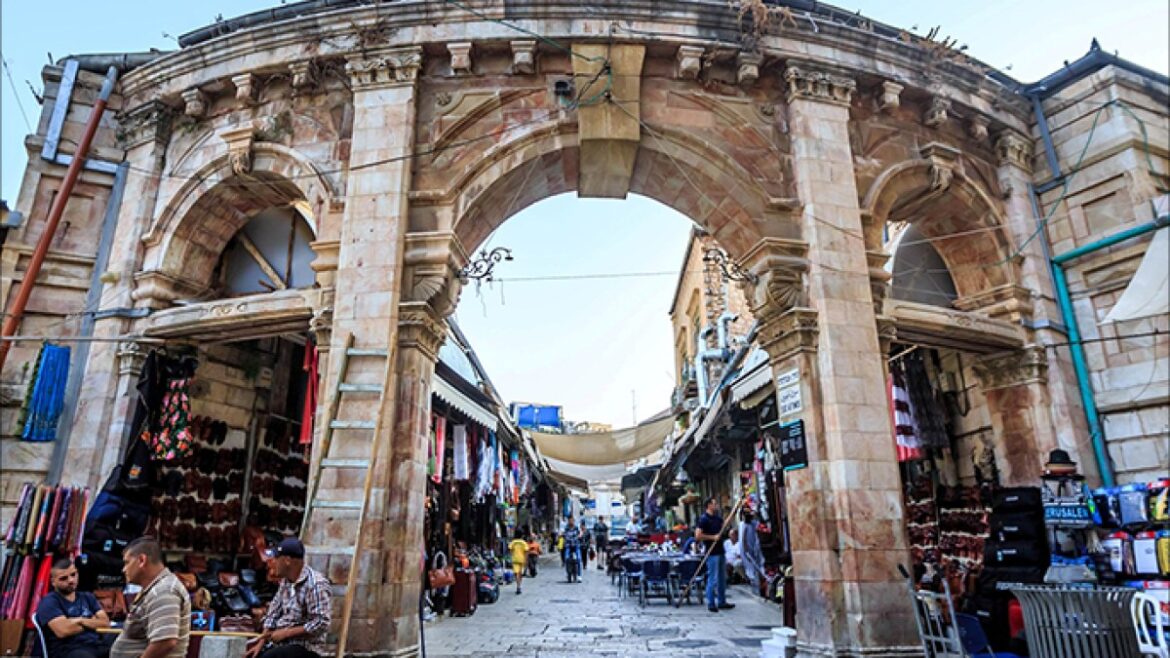Aftimos Market is located in Jerusalem. It dates back to the Ottoman era. It was famous for its antique shops. It has witnessed major transformations in the nature of its activities. It is still active and an important attraction for tourists.
the site
Aftimos Market is located in the heart of the Old City of Jerusalem, specifically to the west of the Lutheran Church of the Savior, and to the southeast of the Church of the Holy Sepulcher.
The market’s location is strategic due to its proximity to important historical landmarks, making it a major attraction for visitors and tourists.
Space and design
The area of Aftimos Market is about 13 dunums, and it is distinguished by the presence of 4 entrances leading to a central square with a classic water fountain in the middle, decorated with statues, and drawing its inspiration from Roman styles, which added a distinctive historical touch to the market.
The fountain was established in 1901 AD, in honor of the Ottoman Sultan Abdul Hamid, on the occasion of the 25th anniversary of his accession to power.
Label
The market was named after the Greek Archimandrite Avtimos, who established it in 1908 AD by order of the Greek Orthodox Patriarch Aurelianos.
History and development
The market was the headquarters of the Knights of Saint John, and it contained a church named after him. After the Ayyubid liberation of Jerusalem, the area became known as “Al-Morstan” or Saladin Hospital, and this continued until the Ottoman period. Over time, the market weakened and was sold to the Greek Patriarchate, which in turn established the modern market known as “Aftimos.”
In its beginnings, the market was a vital center for the leather industry, and it included many craftsmen specialized in tanning. But over time, he witnessed major changes in the nature of his activities as a result of the Israeli occupation.
Shops selling traditional and heritage goods have replaced tanning shops, and restaurants and cafes targeting foreign tourists have also appeared.

Challenges and transformations
Aftimos Market went through difficult periods, especially after the Israeli occupation, which greatly affected the commercial movement there. Many stores were transformed into restaurants and cafes, while the one close to the Church of the Holy Sepulcher continued to sell oriental antiques.
The market also witnessed changes in commercial activities due to political and economic conditions. The tanning craft was negatively affected as a result of the restrictions imposed by the occupation authorities on the introduction of raw materials and the increasing competition from imported goods. This led to the closure of a number of shops, or its activity shifted to selling tourist antiques and finished leather products.
Surrounding churches and mosques
Aftimos Market is a site rich in important religious places, as it contains the Omar bin Al-Khattab Mosque, in addition to 4 prominent churches: the Church of John the Baptist, which is considered the oldest Greek Orthodox church in Jerusalem, and which was built in the fifth century AD; The Church of the Resurrection, which is considered the mother church of Christendom; The German Lutheran Church of the Redeemer, built in 1898 AD; And the Russian Alexander Nevsky Church, built in 1902 AD.

History of settlement in Jerusalem and Aftimos Market
After the occupation of East Jerusalem in 1967, the Israeli occupation authorities began a gradual process of expanding settlements throughout the Old City, and Aftimos Market was among the main targets of this policy.
The settlers seized a number of vital buildings in the market, most notably the guest house, which was owned by the Greek Orthodox Patriarchate.
This building was among the places that were transferred to a settlement association, and it included 36 rooms. This change did not only affect the social fabric of the market, but also its role as a commercial and tourist center.
Settlement operations led to a clear change in commercial activities within Aftimos Market. Many shops that focused on selling traditional and leather products were closed or turned into restaurants and cafes targeting tourists.
Settlement also affected the local economy by increasing pressure on infrastructure and services. Public facilities that served the local Palestinian community also became geared to meeting the needs of settlers, which exacerbated the economic pressures on the indigenous population.
Aftimos Market has become a mixture of tourist and commercial activities targeting foreign visitors, with a significant decline in activities that reflect local Palestinian heritage. Settlement contributed to changing the cultural character of the market, which affected the cultural identity of the region.



